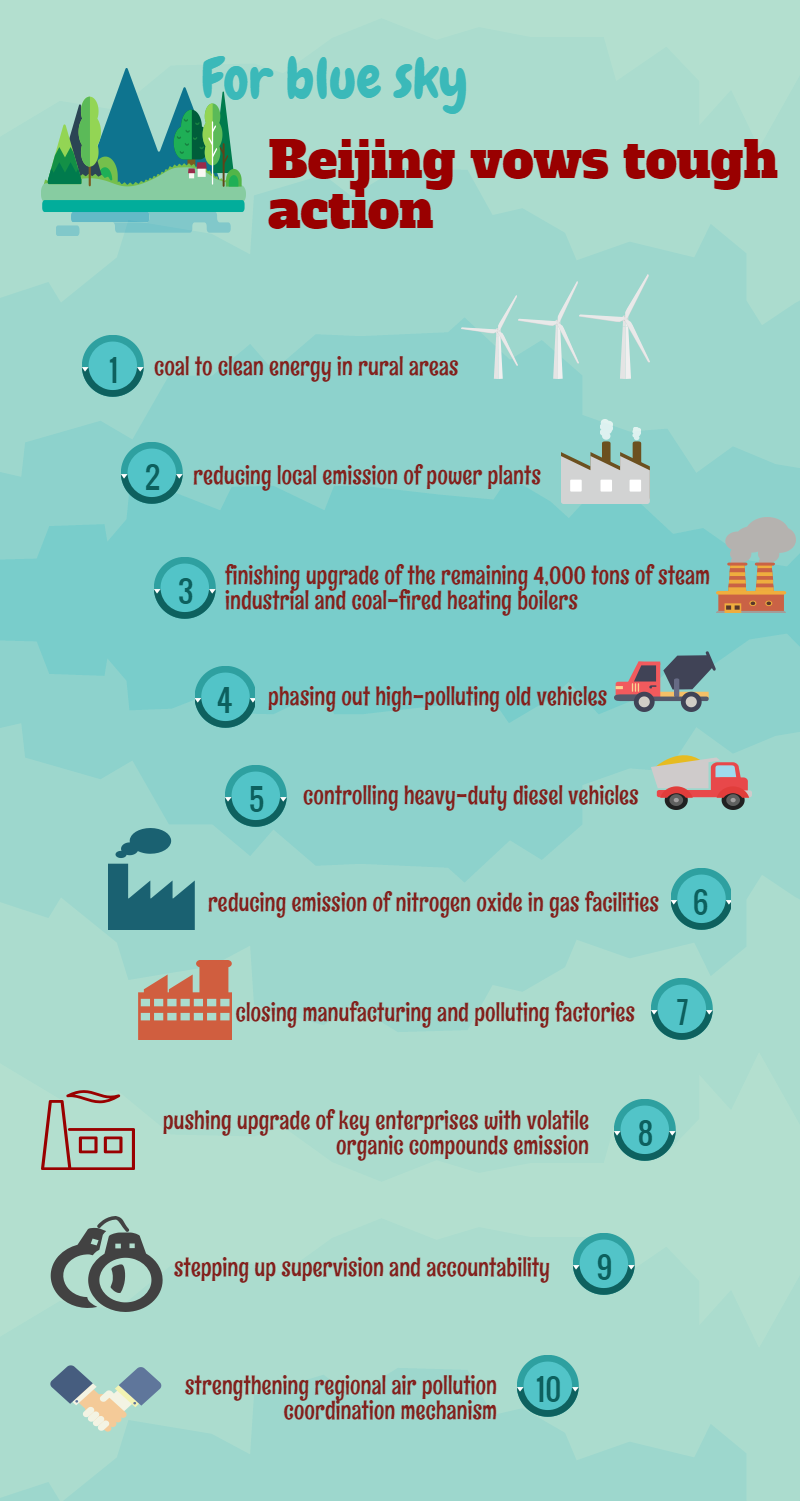

Beijing will take ten ironfisted measures to fight smog this year, according to the Beijing Municipal Environment Protection Bureau.
Early in 1998, the municipality started a large-scale comprehensive campaign against air pollution.
It's never an easy job for Beijing to fight against air pollution for geographical reasons. The capital is embraced on three sides by mountains that prevent diffusion of the air pollutants. The winters and autumns in Beijing have higher risk of heavy air pollution.
Moreover, the more pollution sources are closely connected to the city's everyday operation and residents' daily lives, the more emissions of air pollutants tend to exceed the environmental carrying capacity. As a result, it's harder and harder to keep air quality improving. The capital's air pollution control is therefore now at a critical juncture.
The year 2017 marks the conclusion of the Action plan for Air Pollution Prevention and Control released by the State Council in 2013, which is a guide for national air pollution prevention and control. This year must be a breakthrough period in the battle against air pollution.
In 2017, Beijing will prioritize ten aspects in accordance with a principle of integrating normal control with emergency emission reduction, including changing coal to clean energy in rural areas, reducing local emissions of power plants, phasing out high-polluting old vehicles and strengthening regional air pollution coordination mechanisms.
Read more:
The ten aspects in detail:
First, the capital will continue to change coal to clean energy in rural areas, including 700 villages, and to eliminate coal in the districts of Chaoyang, Haidian, Fengtai and Shijingshan, as well as in the south plain area generally.
Second, it will do its best to reduce local emissions of power plants. The coal-fired units in Beijing Thermal Power Plant of China Huaneng Group will be closed down as the heat supply season concludes.
Third, it will finish upgrading the remaining 4,000 tons of steam industrial and coal-fired heat-supply boilers.
Fourth, it will prioritize control over high-polluting vehicles in 2017. From Feb 15, light-duty gasoline vehicles in accordance with National Ⅰand ⅡEmission Standards will be given limited access within fifth ring and 300,000 older high-polluting vehicles will be phased out over the year.
Fifth, the municipality will focus on control of heavy-duty diesel vehicles. All new heavy-duty diesel vehicles will have to be equipped with diesel particulate filters. Strict investigation of over-emission by heavy-duty diesel vehicles will be carried out, with a focus on muck trucks.
Sixth, it will push to reduce emissions of nitrogen oxide in gas facilities overall, and will complete the low-nitrogen transformation of 10,000 t/h gas-fired boilers across the city in a year.
Seventh, it will make further closures of polluting factories. A total of 2,560 scattered pollution enterprises will have to undergo thorough clean-up and rectification, and 500 more polluting manufacturing enterprises will be closed.
Eighth, it will emphasize upgrading of key enterprises with volatile organic compounds emissions. The Beijing-Tianjin-Hebei region is promoting replacing oil paint with water paint.
Ninth, law enforcement will be much sterner with stepped up supervision and accountability. A designated environmental police force will be established to crack down on environmental crimes.
Tenth, it will strengthen regional air pollution coordination mechanisms. In coordination with the Ministry of Environmental Protection, Beijing will strengthen interaction with surrounding provinces and cities for better emergency response to heavy air pollution.
